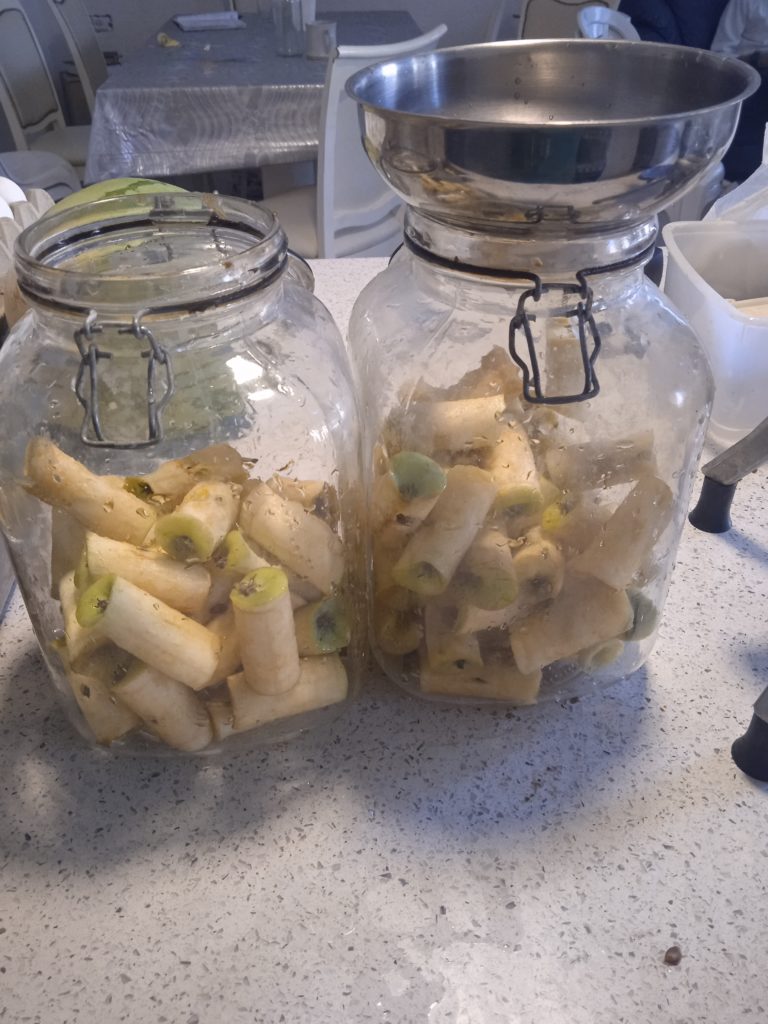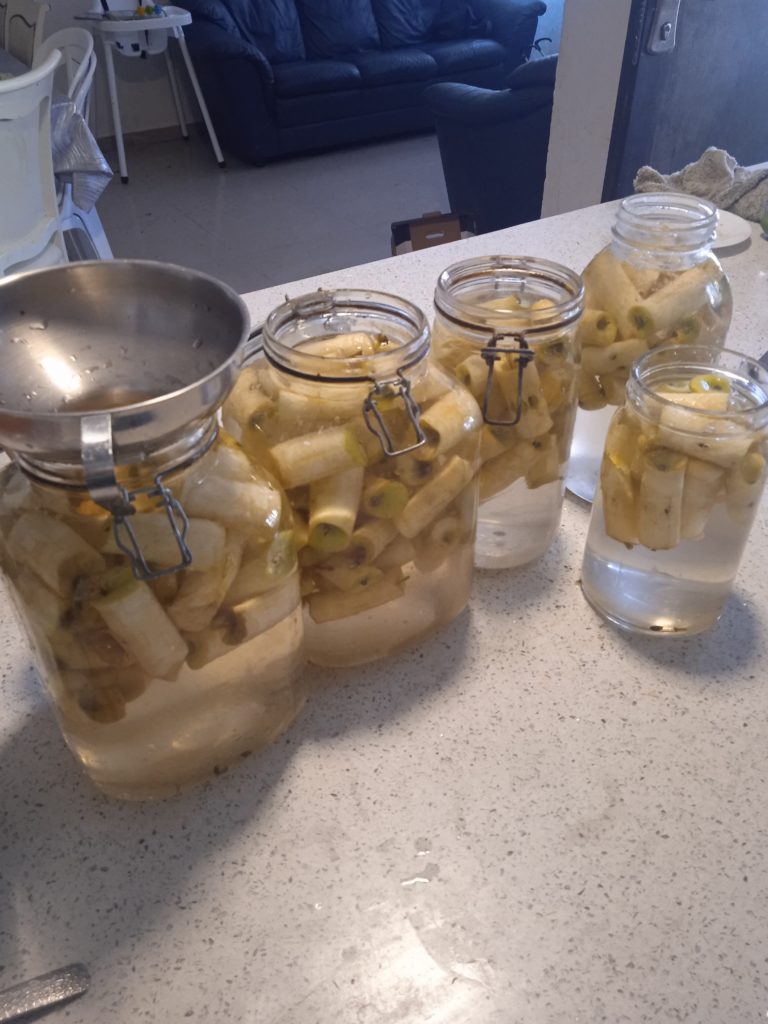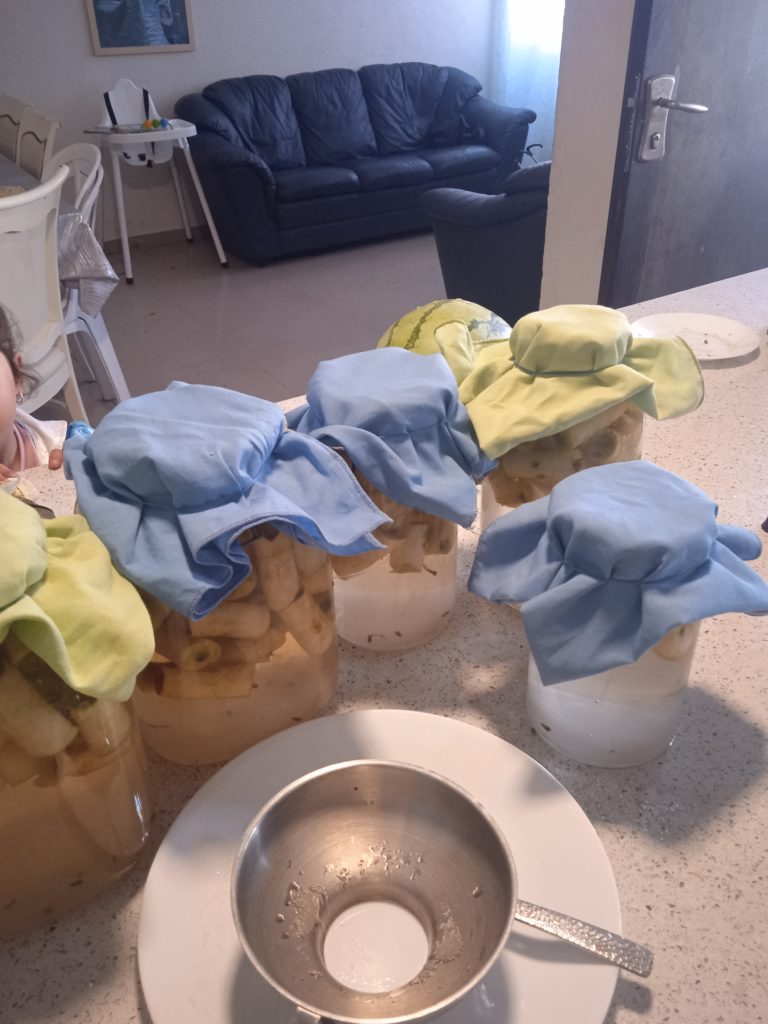This morning I wanted to get an early start in the kitchen this morning. I needed to take dd6 to an introductory meeting at her kindergarten at 9:45, and I was hoping to get some traction on some food preservation before then.
My husband brought home a bunch of apples yesterday. Sometimes I don’t get to fresh produce right away and I always regret it, because it’s so much easier to process food when it’s fresh and blemish-free. I have a apple corer-slicer-peeler but my apple corer sections apples into six pieces and is so much faster that I’m willing to use apples with peels on them. I wasn’t looking at the clock but I felt mighty quick in filling up two large pots with the prepared apples.
I haven’t done much food preservation lately, and today decided to make apple compote, which translated into fifteen quarts/liters once it was cooked. I add a little water, some vanilla and let it cook down slowly. It’s so flavorful and as it was cooking, several times dd6 and gd4 asked me what that good smell was! Usually I add cinnamon but I didn’t feel like it this time. Of course I canned all of those lovely jars so I can keep them on a shelf instead of in a fridge. It makes me smile thinking of pulling them out in a few months for dessert for Shabbos dinner.
The next logical step was to do something with all the beautiful cores, so I decided to make apple cider vinegar.

Making apple cider vinegar is really easy: first fill a jar halfway with apple scraps.

Add water to fill the jar until about an inch from the top. Add a tablespoon of sugar per cup of water you used.

Cover it with a cloth and stir it once a day for a couple of weeks.

Then let it sit for a couple of months until it’s ready, and strain it out. That’s it.
I keep mine on the counter for the first couple of weeks so I can stir it daily to be sure everything stays submerged under the liquid , then put it away somewhere out of my immediate kitchen zone to finish fermenting. Last year I was really happy with how delicious the apple cider vinegar was. I told you then that it was so good I wanted to drink it by the cupful!
I got all that finished and had about forty five minutes to spend with my grandchildren before I needed to leave with dd6 at 9:40 am.
Later in the day, I turned my attention to the cabbages.

I wanted to turn them into sauerkraut, but I don’t have a cellar or basement or even a home that is usually air conditioned to keep the temperature low for an extended time. If I would shred the cabbage as I usually do, it would ferment within three days. Everything ferments much more quickly in the heat. I decided to chop the cabbage coarsely for the next batch so it would take a longer time to ferment. I made two four liter buckets full, which will be much less once it breaks down and compacts, but will still be a nice amount.
That was enough food preservation for today, first of all because I was tired and secondly because then I needed to make dinner, put the kids to bed early and leave to ds6.5’s introductory school meeting, this one only for mothers. It was on arriving there that I learned he’s going to be going into first grade, not gan chova (pre1A). His teacher looks wonderful, as all of the teachers in this school have been. I’ve been very happy with this school and feel so fortunate that by moving here, our boys have a great place to learn.
Tomorrow I have a meeting with ds6 and his new teacher. They started hiring staff a week ago and it looks like the gan is actually going to start on time on September 1st! Since my husband and older boys won’t be home at that time of day, I’m going to be taking the other three kids with me to this meeting. It will be short and everyone will enjoy seeing his school – the twins went to Siblings Day at ds11’s school and saw his class and ds6/5’s gan. And then I took everyone to see dd6’s gan prior to the meeting today.
Back to food preservation: a couple of days ago, for the first time in ages I made lacto fermented pickles. In the past I’ve sometimes made amazing, delicious pickles, but it’s so unpredictable how they’ll turn out – sometimes they are just not good. I finally decided to try it again, this time using bay leaves as the tannin source (tannin being the ingredient that keeps the pickles crunchy). Grape leaves are recommended and I have loads of them on my vine, but I have another year until we can harvest the grapes, and I don’t know if the grape leaves have the same status. No, it wasn’t important enough to me to call a rabbi to ask.
I wanted to use tea bags but I didn’t know where my husband put them and when I saw that bay leaves are a tannin source, figured I’d use them. I bought a kilo bag of bay leaves over a year ago. Do you have any idea how huge a quantity that is? I’ve hardly made a dent in them. So if these work well for crunchy pickles, there’s a lot more I need to use up. If you live locally and want some bay leaves, I’m happy to share. 🙂
After a day and a half, I put them in the fridge. I hope the experiment will be successful, since most of us in the family really like pickles, and they’re so much healthier, tastier and cheaper when you make them yourself.
Avivah


